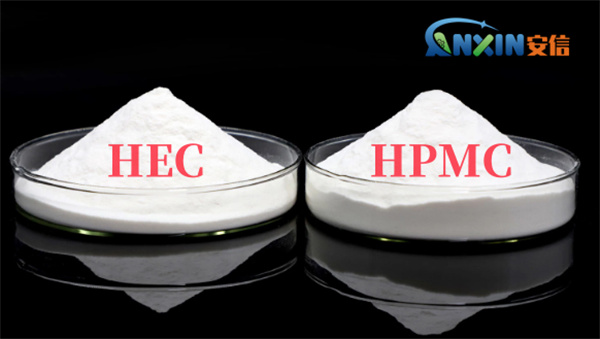Hydroxyethyl Cellulose (HEC) and Hydroxypropyl Methylcellulose (HPMC) are both non-ionic, water-soluble cellulose ethers derived from natural cellulose. They are widely used in industrial, pharmaceutical, personal care, and food applications due to their excellent thickening, film-forming, stabilizing, and emulsifying properties. While they share some similarities in origin and function, their differences in chemical structure result in distinct physical properties and applications.
1. Origin and Chemical Structure
Cellulose Ethers
Both HEC and HPMC are synthesized by chemically modifying natural cellulose, which is a polymer composed of β-D-glucose units linked by β(1→4) glycosidic bonds. Cellulose itself is insoluble in water, but through chemical modification, it can be transformed into water-soluble derivatives.

Hydroxyethyl Cellulose (HEC)
HEC is formed by reacting cellulose with ethylene oxide, introducing hydroxyethyl groups (-CH2CH2OH) along the polymer chain. This modification increases water solubility and improves the ability of the polymer to form clear and stable solutions. The substitution occurs primarily at the hydroxyl (-OH) sites of the anhydroglucose units in the cellulose chain.
Hydroxypropyl Methylcellulose (HPMC)
HPMC is synthesized by reacting cellulose with methyl chloride and propylene oxide, resulting in the substitution of hydroxyl groups with methoxy (-OCH3) and hydroxypropyl (-CH2CHOHCH3) groups. The ratio of methoxy to hydroxypropyl content can be varied to tailor the polymer’s properties.
2. Physical Properties
Solubility
HEC: Soluble in both hot and cold water, forming clear, viscous solutions. It is not soluble in most organic solvents.
HPMC: Also soluble in cold water but forms a gel when heated. It is insoluble in hot water but swells and forms reversible gels on heating, which is useful in controlled-release drug delivery. Some grades may also be soluble in organic solvents like ethanol or acetone.
Viscosity
Both HEC and HPMC can be manufactured in various viscosity grades. HEC solutions generally offer high clarity and are less temperature-sensitive. HPMC viscosity tends to be more stable across a wide pH range (3–11) and has good pseudoplastic behavior (shear-thinning), which is beneficial in coatings and pharmaceuticals.
Thermal Gelation
HEC: Does not exhibit thermal gelation.
HPMC: Exhibits thermal gelation. Upon heating, the polymer solution undergoes a phase transition, turning into a gel. This is exploited in food and drug formulations.
3.Functional Properties
|
Property |
HEC |
HPMC |
| Thickening Agent | Yes, especially in aqueous systems | Yes, effective in both aqueous and some organic systems |
| Film-forming | Good | Excellent |
| Emulsifying Agent | Moderate | Good |
| Stabilizer | Yes | Yes |
| Adhesive Properties | Limited | Good, especially in construction |
4. Applications
Hydroxyethyl Cellulose (HEC)
HEC is widely used in applications requiring viscosity control and stabilization, especially in water-based systems.
Paints and Coatings: Used as a thickener and stabilizer to prevent pigment settling and improve application properties.
Personal Care: Found in shampoos, conditioners, and lotions for its thickening and rheology-modifying properties.
Pharmaceuticals: Used as a binder and thickener in topical formulations.
Construction: In cement and mortar as a water-retention agent and to enhance workability.
Oilfield Chemicals: Used in drilling fluids for viscosity control and fluid loss prevention.
Hydroxypropyl Methylcellulose (HPMC)
HPMC is notable for its versatility in both hydrophilic and controlled-release drug delivery systems and as a binder or film former.
Pharmaceuticals: Widely used in oral tablets (as a binder, coating agent, or matrix former for sustained release), ophthalmic solutions, and topical gels.
Food Industry: Approved as a food additive (E464) and used as a thickener, emulsifier, and stabilizer.
Construction: Used in dry mix mortars, tile adhesives, and plasters for improved water retention, adhesion, and workability.
Cosmetics: Used in creams, gels, and eye drops.
Paints: Similar to HEC, used in water-based formulations for rheology control
5.Key Differences
|
Feature |
HEC |
HPMC |
| Substituents | Hydroxyethyl groups | Methoxy and Hydroxypropyl groups |
| Thermal Gelation | No | Yes |
| Organic Solvent Compatibility | Poor | Moderate to good (depending on substitution) |
| Film Quality | Moderate | Excellent |
| Controlled Drug Release | Limited use | Widely used in matrix systems |
| Food Applications | Not commonly used | Widely used (E464) |
6. Safety and Biocompatibility
Both HEC and HPMC are considered safe and non-toxic. They are not absorbed systemically when used topically or orally in typical concentrations. HPMC has GRAS (Generally Recognized as Safe) status and is widely used in pharmaceutical and food industries due to its excellent biocompatibility and regulatory acceptance.

HEC and HPMC are versatile, water-soluble polymers with distinct properties tailored to specific industrial and pharmaceutical needs. While both offer excellent thickening and stabilizing functions, HPMC stands out in pharmaceutical and food applications due to its thermal gelation and biocompatibility. HEC, on the other hand, is more common in water-based applications like paints and cosmetics due to its clarity and consistency in aqueous systems.
Post time: Apr-23-2025